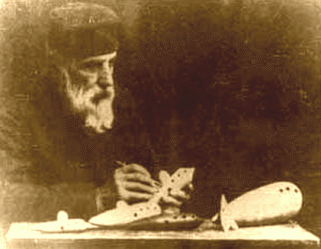Ag seinm uirlisí ceoil, ó alpchorn go xileafón (Alpenhorn to Xylophone in Irish, Pt.2): ideafón go hócairín Posted by róislín on Mar 21, 2015 in Irish Language
(le Róislín)

Cén uirlis cheoil atá á déanamh sa phictiúr seo? Ar sheinn tú riamh an uirlis cheoil seo? (fearann poibli: http://commons.wikimedia.org/wiki/File:Giuseppe_Donati_and_one_of_his_ocarinas.gif, Aaron Walden a d’uaslódáil)
In the last blog we looked at musical instruments from “a” (alpenhorn) to “h” (heckelphone) as part of a series on naming instruments AND saying someone is playing them. And yes, we did a couple more widely played instruments, like “an consairtín” and “na drumaí,” not just some of the less usual ones.
Why the big “AND”? Remember, Irish has different ending and changes that occur when you say “I’m playing the guitar” (Tá mé ag seinm an ghiotáir) as opposed to “Here’s the guitar” (Seo é an giotár). When spelled “ghiotáir,” the word is pronounced “yit-AWRzh” and when it’s in its root form, it’s, predictably, “git-AWR.” In more technical terms, “giotár” changes to the genitive-case form when you’re saying someone is “at the guitar’s playing,” to give it a literal translation.
So for today’s blog we’ll continue in sequence, starting with idiophones and ending with the ocarina. As before, I’ll fill in every other line for the genitive forms, and leave blanks for you to fill in for the others.
(1-8 sa bhlag ar 19 Márta 2015)
9) ideafón: Tá mé ag seinm an ideafóin. I’m playing the idiophone. OK, it’s not your everyday statement, and would probably come up mostly if you were contrasting the categories of instruments being played in an ensemble, like na gaothuirlisí adhmaid, na téaduirlisí, na cnaguirlisí agus na huirlisí práis.
Can you think of some idiophones? Seo cúpla cineál a bhuailtear (ideafóin bhuailte): triantán, cloganna. Agus cúpla cineál a stoitear (ideafóin stoite): trumpa béil, dan moi (uirlis Vítneamach, focal ar fhocal: “liúit liopa”). Cineál amháin a shéidtear: aeolsklavier (níl Gaeilge air, sílim) agus ní fheicim ceann ar bith eile. Agus cúpla ceann a sheinntear le frithchuimilt: armónach gloine, caschlár.
And by the way, note the spelling in English: i-d-i-o-phone (idio- own, peculiar, proper to one + -phone, i.e. for music, naturally sonorous) and in Irish i-d-e-a-fón. If you Google the term, you might get led down the garden path, like I was briefly, by lots of hits for Lenovo’s “IdeaPhones,” a type of smartphone. The Irish “idea-” prefix is a gaelicization of “idio-,” also found in a handful of other words, like “ideapatach” (fibriliú ideapatach méadailíneach) and “ideamorfach” (criostal ideamorfach).
OK, back to the list. I didn’t really plan for one entry to dominate the list, but the tricky thing is that there aren’t many instruments beginning with “i” in Irish, so I went with the group term “idiophone” instead.
And now, your turn, noting that there are no typical instruments starting with “j” in Irish. The letter “j” is pretty rare in Irish, mostly limited to loan words like “jib,” “jíp,” and “júdó.”
The letter “k” is even less typical in Irish, mostly reserved for the abbreviation “km” (the abbreviation for “ciliméadar” — using “cm” would be confused with “ceintiméadar“).
Sure, we could say, “Tá mé ag seinm an janggo” (uirlis Chóiréach) or “Tá mé ag seinm an kakko” (uirlis Sheapánach), but that wouldn’t really give us much Irish practice. So, moving right along …
10) liúit: Tá mé ag seinm na ___________ (NB: inscne — baininscneach, so no lenition but what happens to the end of the word?)
Mo shealsa
![Mórorgán Wanamaker i bhFilideilfia (Nikita52389 at en.wikipedia [CC BY 3.0 (http://creativecommons.org/licenses/by/3.0)], from Wikimedia Commons)](https://blogs.transparent.com/irish/wp-content/uploads/sites/17/2015/03/397px-The_Grand_Court-wanamaker-organ-nikita-wikimedia.jpg)
Mórorgán Wanamaker i bhFilideilfia (Nikita52389 at en.wikipedia [CC BY 3.0 (http://creativecommons.org/licenses/by/3.0)], from Wikimedia Commons)
Do sheal anois
12) nóvachorda: Tá mé ag seinm an ______. (NB: 4th-declension noun, starting with “n,” so is there really any change? Do bharúil?)
13) ócairín: An maith leat a bheith ag seinm an ócairín? (NB: also 4th-declension, starting with a vowel, so, creid nó ná creid é, níl athrú ar bith ann; in other words, the word stays as “ócairín“). Dála an scéil, sin an uirlis atá sa phictiúr ag barr an bhlag seo. Tuilleadh eolais faoin bhfear ag http://en.wikipedia.org/wiki/Giuseppe_Donati.
Bhuel, that’s another five instruments (cúig uirlis), seven (seacht gcinn) if you count the “j” and “k” ones. And relatively few changes this time around. Bhí an t-ádh orainn, nach raibh? SGF – Róislín
Freagraí
10) liúit: Tá mé ag seinm na liúite. The word “liúit” is feminine, and second-declension, so it gets “-e” added here. No change in spelling to the initial “l.”
12) Tá mé ag seinm an nóvachorda. No changes!

Build vocabulary, practice pronunciation, and more with Transparent Language Online. Available anytime, anywhere, on any device.




Comments:
Brús:
So … how is xileafón pronounced? Specifically, how is the x pronounced?
róislín:
@Brús The word “xileafón” is pronounced with the “x” like the “s” of “treasure” or “pleasure” or the “j” of French “Jacques.” This sound is often indicated as “zh” in rough pronunciation guides. So a rough guide would be: ZHIL-yuh-fohn. In IPA symbols, according to Foclóir Póca, it’s /’z΄il΄ә ̩fo:n/. That’s using the Irish-modified IPA, not quite standard IPA. The vertical ‘ mark before the “z” indicates that this is the stressed syllable, paralleling the English (XY-lo-phone). The slanted ΄ mark after the “z” indicates that it’s like “zh,” not like the “z” of “zoo.” The same slanted ΄ mark after the “l” means the “l” is slender, somewhat like the “l” in “million” and not like the initial “L” of “Louisville.” HTH!